
Forest garden experiments
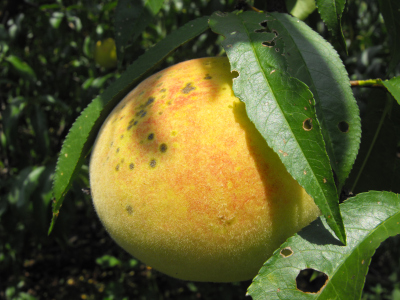 I'll
end my run-down on 2010 experiments with the ones nearest and dearest
to my heart --- the forest garden. My forest garden trials are by
far the most experimental, so it's no surprise that most of them didn't
do all that well. You should also keep in mind that I planted my
primary forest garden in the worst part of the yard, where the topsoil
eroded away under the care of previous owners leaving behind solid clay
with an abnormally high groundwater. Quite possibly, these
techniques would have worked in more prime garden soil.
I'll
end my run-down on 2010 experiments with the ones nearest and dearest
to my heart --- the forest garden. My forest garden trials are by
far the most experimental, so it's no surprise that most of them didn't
do all that well. You should also keep in mind that I planted my
primary forest garden in the worst part of the yard, where the topsoil
eroded away under the care of previous owners leaving behind solid clay
with an abnormally high groundwater. Quite possibly, these
techniques would have worked in more prime garden soil.
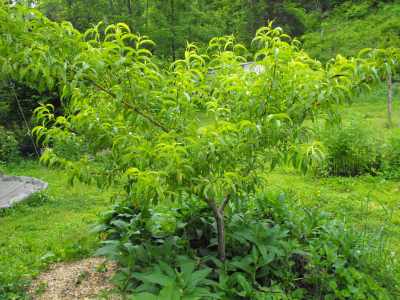 I've
read in several books that comfrey makes a great living mulch beneath
fruit trees, sucking up nutrients from deep in the subsoil with its
taproots and then depositing the hard-to-find minerals right by the
tree roots. Unfortunately, my
experience with comfrey around fruit trees is entirely negative ---
the tree with comfrey around its base seems to be growing slower and
its summer leaves were yellowish, suggesting that the comfrey is
fighting the tree for nitrogen. While this experiment has no
control (I put the comfrey around my only nectarine and can only
compare it to the closely related peaches planted in another part of
the yard), I'd be leery of planting comfrey around any other fruit
trees, and am planning on putting down a kill mulch to try to eradicate
the comfrey from around my nectarine. It's possible that comfrey
makes a good living mulch around the drip-line of more established
fruit trees, but for now I'm sticking to planting my comfrey where it
won't fight with anyone, then cutting the leaves for mulch.
I've
read in several books that comfrey makes a great living mulch beneath
fruit trees, sucking up nutrients from deep in the subsoil with its
taproots and then depositing the hard-to-find minerals right by the
tree roots. Unfortunately, my
experience with comfrey around fruit trees is entirely negative ---
the tree with comfrey around its base seems to be growing slower and
its summer leaves were yellowish, suggesting that the comfrey is
fighting the tree for nitrogen. While this experiment has no
control (I put the comfrey around my only nectarine and can only
compare it to the closely related peaches planted in another part of
the yard), I'd be leery of planting comfrey around any other fruit
trees, and am planning on putting down a kill mulch to try to eradicate
the comfrey from around my nectarine. It's possible that comfrey
makes a good living mulch around the drip-line of more established
fruit trees, but for now I'm sticking to planting my comfrey where it
won't fight with anyone, then cutting the leaves for mulch.
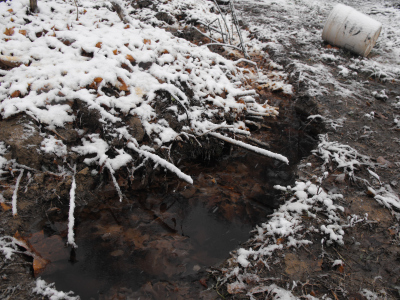 Meanwhile,
I installed swales around several fruit trees
in an attempt to drain a bit of water away from their roots and keep
the forest garden from turning into a morass of mud in the
winter. In areas where the groundwater is extremely high, the
swales just made the muddy area larger --- ditches would have been a
better choice. On the other hand, in moderately problematic area,
the swales nearly did the job, just leaking a bit of water to the
downhill side. When I find enough organic matter, I plan to fill
the good swales up with mulch and also to add an extensive kill mulch
around each fruit tree in this trouble area so that the tree roots can
benefit from the concentrated water in the dry period of summer.
Meanwhile,
I installed swales around several fruit trees
in an attempt to drain a bit of water away from their roots and keep
the forest garden from turning into a morass of mud in the
winter. In areas where the groundwater is extremely high, the
swales just made the muddy area larger --- ditches would have been a
better choice. On the other hand, in moderately problematic area,
the swales nearly did the job, just leaking a bit of water to the
downhill side. When I find enough organic matter, I plan to fill
the good swales up with mulch and also to add an extensive kill mulch
around each fruit tree in this trouble area so that the tree roots can
benefit from the concentrated water in the dry period of summer.
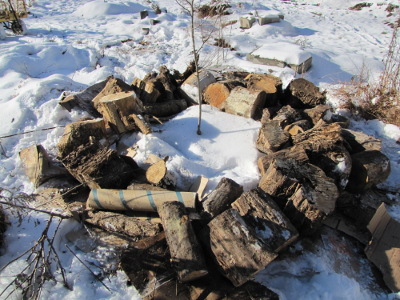 My hugelkultur mounds
--- rotting wood topped with soil --- did what I wanted only too
well. I hoped they would keep plants out of the groundwater in
the trouble spots, but the small amount of soil and large amount of
not-yet-rotted wood in the mounds meant that during year one, they were
too dry for anything except rosemary. Also, Lucy loved
digging my mounds up in search of small mammals. On the other hand, I
think that hugelkultur has a lot of potential for my forest garden if I
can put them in spots where nothing needs to grow for a year or two
until the wood really breaks down. This year, I'm creating
hugelkultur extensions to each tree mound to give my fruit trees more
dry ground to spread out, and this time I'm putting a layer of
cardboard below each mound so tenacious weeds won't grow up through.
My hugelkultur mounds
--- rotting wood topped with soil --- did what I wanted only too
well. I hoped they would keep plants out of the groundwater in
the trouble spots, but the small amount of soil and large amount of
not-yet-rotted wood in the mounds meant that during year one, they were
too dry for anything except rosemary. Also, Lucy loved
digging my mounds up in search of small mammals. On the other hand, I
think that hugelkultur has a lot of potential for my forest garden if I
can put them in spots where nothing needs to grow for a year or two
until the wood really breaks down. This year, I'm creating
hugelkultur extensions to each tree mound to give my fruit trees more
dry ground to spread out, and this time I'm putting a layer of
cardboard below each mound so tenacious weeds won't grow up through.
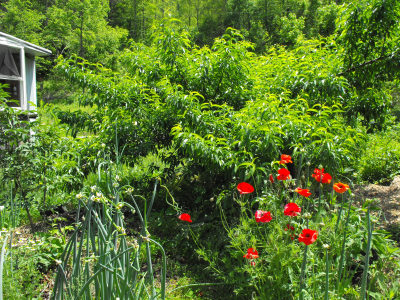 As
you can tell from the photos, my favorite part of the forest garden is
that I get to play with it in the winter when a dormant vegetable
garden combined with the garden itch would otherwise itch drive me
nutty. The forest garden pretty much takes care of itself for the
rest of the year, so it's hard to complain about some growing
pains. And, lest you still become disheartened from this dismal
list of problems, I should also tell you that my forest
garden island (in
the portion of the garden with good soil) is huge and provided masses
of fruits for us --- clearly, permaculture concepts have a lot of merit
even if they have to be tweaked a bit to work in the most problematic
parts of the yard.
As
you can tell from the photos, my favorite part of the forest garden is
that I get to play with it in the winter when a dormant vegetable
garden combined with the garden itch would otherwise itch drive me
nutty. The forest garden pretty much takes care of itself for the
rest of the year, so it's hard to complain about some growing
pains. And, lest you still become disheartened from this dismal
list of problems, I should also tell you that my forest
garden island (in
the portion of the garden with good soil) is huge and provided masses
of fruits for us --- clearly, permaculture concepts have a lot of merit
even if they have to be tweaked a bit to work in the most problematic
parts of the yard.
This post is part of our 2010 experiments lunchtime series.
Read all of the entries:
|
Want more in-depth information? Browse through our books.
Or explore more posts by date or by subject.
About us: Anna Hess and Mark Hamilton spent over a decade living self-sufficiently in the mountains of Virginia before moving north to start over from scratch in the foothills of Ohio. They've experimented with permaculture, no-till gardening, trailersteading, home-based microbusinesses and much more, writing about their adventures in both blogs and books.
Want to be notified when new comments are posted on this page? Click on the RSS button after you add a comment to subscribe to the comment feed, or simply check the box beside "email replies to me" while writing your comment.
